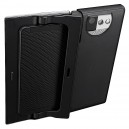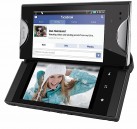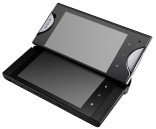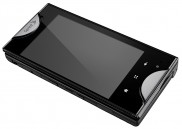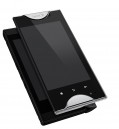Find Our Latest Video Reviews on YouTube!
If you want to stay on top of all of our video reviews of the latest tech, be sure to check out and subscribe to the Gear Live YouTube channel, hosted by Andru Edwards! It’s free!
Tuesday February 8, 2011 12:16 pm
Hands-on with Sprint’s dual-screen Kyocera Echo
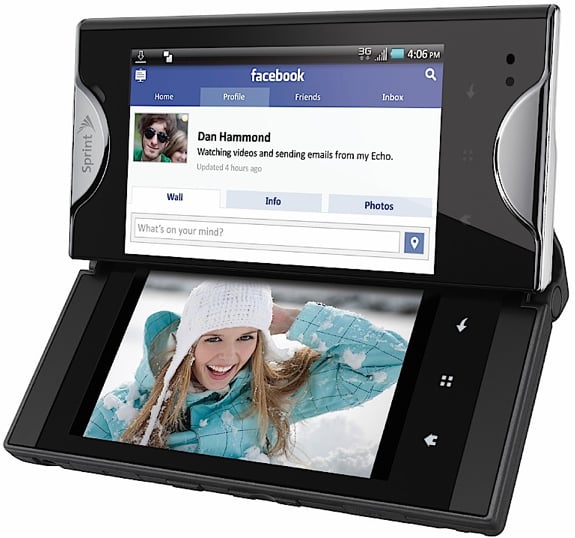
The dual-screen Kyocera Echo smartphone for Sprint lets you do two things at once, or look at the world through a 4.7-inch window. But it's only the vanguard of a legion of dual-screen devices that may be coming to American shelves, Sprint and Kyocera said today.
First, the phone itself: the Echo is a crazy device, but it thinks the way a lot of us do. It multitasks. The Echo starts out as a standard touch-screen Android 2.2 phone, and it works fine like that. But then you slide the 3.5-inch, 800-by-480 LCD screen, it does a strange hingey thing, and pow: the screen almost merges with another screen hidden under it. (Look at the slideshow below to understand.)
The Echo's unique hinge is made out of "liquid metal," Sprint's vice president for device operations Fared Adib said. It felt like plastic to me, but he said it was metal - and when tested, it was stiff and strong. The phone can survive a seven-foot drop test, he said.
You can use the dual screens a few different ways. By default, the phone is like a mini-tablet with a 4.7-inch, 800-by-960 screen. That's a nonstandard Android resolution, so some third-party apps may run with a black border. That's also the least impressive mode; the black bezel in the middle, while very narrow, does get in the way a bit.
Some apps use the two screens for different things. For instance, when playing The Sims, the bottom screen is the control pad, just like on a Nintendo DS. The bottom screen also becomes an uncommonly large touch keyboard (or even a Swype keyboard) when necessary. Typing on the large touch keyboard, with its subtle force feedback, was unusually nice for a touch keyboard.
But the use that really excites me is when you do two totally different things on the two screens. A handful of built-in apps work this way: you can surf a Web page while writing an e-mail, for instance, or pick a photo and toss it to Facebook, or mess with your YouTube queue while watching YouTube.
For obsessive Web browsers and social networkers, I love this phone. Most people multitask on their desktops - I hardly know anyone who keeps one tab open in a Web browser. The Echo lets you flip between different tabs and tasks much more easily than on a non-multitasking phone.
I'm a little concerned about performance. I didn't see any visible problems in my 20-minute hands-on, but the Echo is running a single-core, 1-GHz Qualcomm QSD8255 processor. That chip, running Android, typically handles one application at a time, not two. The Echo is also pushing more pixels than any Android smartphone, or even than the Samsung Galaxy Tab, with the same class of GPU.
Battery life may also be an issue; with both the screens running full blast, you may not get a whole day's worth of use. So Sprint is including a second 1370 mAh battery, with its own charger that attaches to the phone's power cord. You can charge both batteries at once that way. The retail box also includes an 8GB MicroSD memory card.
The Echo will cost $199 when it comes out this spring, Sprint said.
More Dual-Screen Phones Coming
As a single phone, the Echo is a curiosity. The Echo's Android platform is far enough away from the norm that it'll be hard to get third-party developers to write dual-screen aware applications, although some major game companies (including EA) seem to be on board.
Kyocera aims to turn this into a platform, though. Kyocera will have multiple dual-screen phones coming out, and the company is working with Google to open-source the dual-screen overlay to Android. Kyocera spokesman John Chier said he'd be happy for Motorola or HTC to produce their own dual-screen devices.
"We see [a wider range of dual-touch phones] as virtually inevitable," Chier said. "But this is also not just for others. We see it as a platform for us. This is the first generation."
But what does this mean for Android? Unless Google embraces dual screens as part of the main Android code base, this is the manufacturer skin to end all manufacturer skins; it's such a huge alteration to Android that it seems like it would be a huge task to upgrade this phone when new Android versions come out.
"We've tried to keep as much of this the same as we can. [But] sometimes you have to bleed and lead in innovation to jump-start a market, and what we're doing is we've created a new category here with dual-touch screens," Adib said.
This article, written by Sascha Segan, originally appeared on PCMag.com and is republished on Gear Live with the permission of Ziff Davis, Inc..
Gallery: Hands-on with Sprint's dual-screen Kyocera Echo
Latest Gear Live Videos
Advertisement
Advertisement
Advertisement
© Gear Live Inc. {year} – User-posted content, unless source is quoted, is licensed under a Creative Commons Public Domain License. Gear Live graphics, logos, designs, page headers, button icons, videos, articles, blogs, forums, scripts and other service names are the trademarks of Gear Live Inc.



